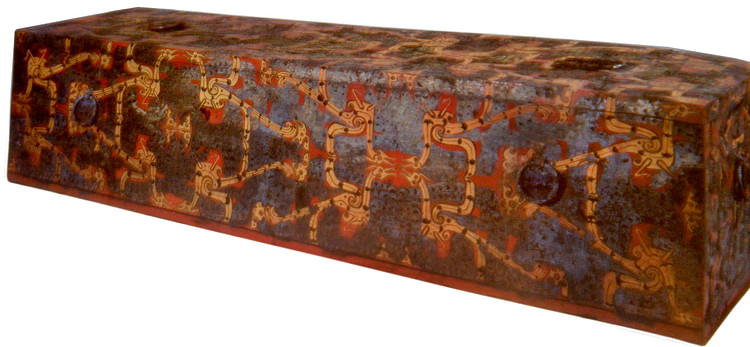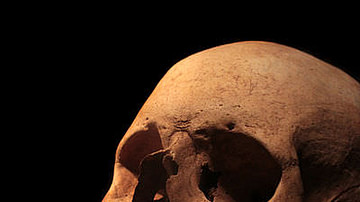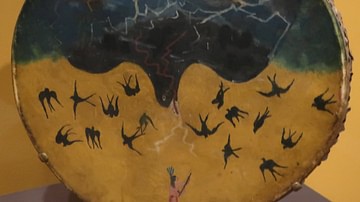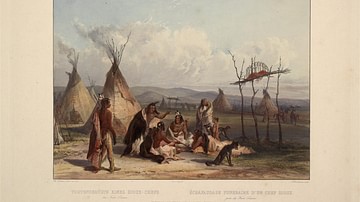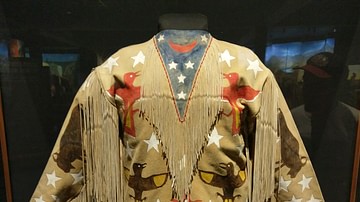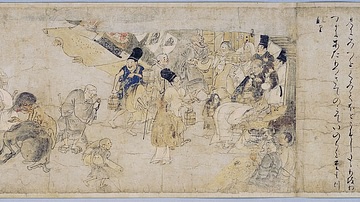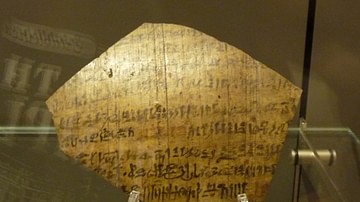Ancestor worship in ancient China dates back to the Neolithic period, and it would prove to be the most popular and enduring Chinese religious practice, lasting well into modern times. The family was always an important concept in Chinese society and government, and it was maintained by the twin pillars of filial piety and respect for one's dead ancestors. The practice of regularly paying homage to one's deceased relatives was further supported by the ever-popular principles of Confucianism which stressed the importance of family relations.
Origins & Immortality
The earliest evidence of ancestor worship in China dates to the Yangshao society which existed in the Shaanxi Province area before spreading to parts of northern and central China during the Neolithic period (c. 6000 to c. 1000 BCE in this case). In the Shang dynasty (c. 1600 - 1046 BCE) the ancestors of the royal family were thought to reside in heaven within the feudal hierarchy of other spirit-gods. These ancestors, it was believed, could be contacted via a shaman. In the Zhou period (1046 - 256 BCE), the ancestors of rulers had their own dedicated temples, typically within the royal palace complexes, and the presence of such a temple was even a definition of a capital city in the 4th century BCE.
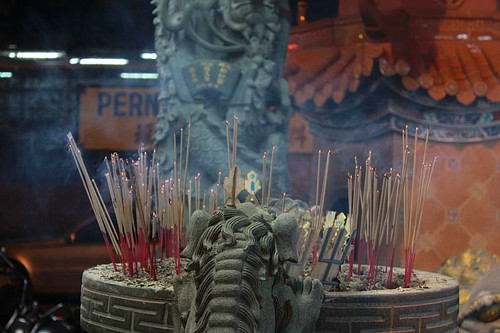
According to ancient beliefs, each person had a spirit which required the offering of sacrifices, not just royal figures. It was thought that an individual had two souls. After death, one of these souls, the po, rose to heaven while the other one, the hun, remained in the body of the deceased. It was this second soul that required regular offerings of nourishment. Eventually, the hun soul would migrate to the fabled Yellow Springs of the afterlife, but until that time, if the family did not want the spirit of their dead relation to trouble them as a wandering hungry ghost, they had to take certain precautions. The first was to bury the dead with all the essential daily objects (or models of them) they would need in the next life from food to tools. Next, to ensure the corpse remained at peace, it was necessary to offer appropriate and regular offerings.
There was then an ancient belief in the mutually beneficial connection between the living and dead, as here explained by the historian R. Dawson:
Ancestor worship was seen by the mass of the people as a reciprocal arrangement between the dead and the living, in which the latter looked after the supposed physical needs of the former, while in return the ancestors benignly participated in the affairs of the living, receiving news of important events such as births and betrothals, and advising and conferring benefits upon their descendants. They were still thought of as part of the family in the same way as the bureaucratically organised gods of the popular religion were an extension of the political order reigning on earth. (154)
A further dimension of immortality in China was the idea of shou or longevity. Not only did this mean while alive but also in death. Remembering the dead and reverently treasuring their name perpetuated the person's shou. A name could be thus remembered by maintaining a shrine and making offerings to the deceased but another effective method was via literature. Particularly from the Han period (206 BCE - 220 CE), poems and texts were composed to honour dead family members and perpetuate both their name and deeds. One Han dynasty poem has this to say on the subject of remembrance:
Prosperity and decline each has its season,
I grieve that I did not make a name for myself earlier.
Human life lacks the permanence of metal and stone.
How could we lengthen its years?
We suddenly transform, in the way of all matter,
but a glorious name is a lasting treasure.
(Lewis, 175)
Shrines & Sacrifices
Ancestor worship began with a son's filial piety for his father while still alive. When the father died the son was expected to follow certain conventions, known as the "Five Degrees of Mourning Attire", as here explained by the historian M. E. Lewis:
If a son mourned his father, he wore the most humble clothes (an unhemmed, coarse hemp garment) for the longest time (into the third year following death). If he mourned a paternal great grandfather's brother's wife, then he wore the least humble clothing (the finest hemp) for the shortest time (three months). (175)
At the public grave of the deceased, an inscribed stone stele was set up to commemorate the lost family member in name and deed. One example inscription reads thus,
By engraving the stone and erecting this stele, the inscription of merit is made vastly illustrious. It will be radiant for a hundred thousand years, never to be extinguished…Establishing one's words so that they do not decay is what our ancestors treasured. Recording one's name on metal and stone hands it down to infinity. (Lewis, 177)
The emperors, perhaps unsurprisingly, had the grandest shrines dedicated to their ancestors and especially so for the founder of the dynasty. The Founder of the Han dynasty, Emperor Gaozu, had his own ancestral shrine in every commandery across the empire, and by 40 BCE there were 176 such shrines in the capital and another 167 in the provinces. These shrines required a combined staff of over 67,000 and received almost 25,000 offerings each year before their eventual reduction. The move to reduce the imperial shrines may have been an economic necessity but it also helped reinforce the idea that the reigning emperor, with his Mandate of Heaven, was the Son of Heaven and so now more important than his dead predecessors.
Offerings were regularly made at the family cemetery, temple, or shrine. These took the form of food and drink, or the burning of incense, and were carried out on significant dates such as New Year's Day. For imperial ancestors, there were more extravagant ceremonies involving musicians and dancers, and gifts, too, of precious goods and engraved bronze vases, as well as the more sober religious offerings.
Another group of ancestors who received particular worship were those founders of and deceased senior figures belonging to clans. Family groups of this kind were so integral to the functioning of Chinese society that the elders were given legally-recognised powers and responsibilities by the state. These extended family groups shared the same surname in rural villages and together saw that the ancestral graves of the clan, which were located together in the family cemetery, were tended and offered the appropriate sacrifices. A family group might even have its own temple where two or three large ceremonies were held annually and the collective achievements of the clan were celebrated.
Sacrifices were made at the family shrine of more modest individuals by the head of the extended family, usually the most senior living male. This was another motivation besides economics for parents to wish for male offspring as only they could ensure the continuance of ancestral ritual and, in their own person, ensure the survival of the family name. The offerings made to ancestors were devoted to the senior males of the previous three generations who were no longer living. For emperors, the last four generations were venerated, and for all groups, the founder of the family was perpetually remembered by rituals and offerings. The shrine or temple for aristocratic families was either separate from or part of the family home.
The home of ordinary citizens had a dedicated room where inscribed wooden tablets were set up which recorded the names, genealogies, and achievements of the most important male and some female ancestors. Where there was more than one son, the elder son would keep the tablets in his home. As only three generations of ancestors were generally worshipped, the oldest tablets were periodically taken and burned or buried at the grave site of the individual mentioned on the tablet. If the tablets belonged to a clan important enough to have its own ancestral temple, then they were taken there for safekeeping. These tablets were also important in wedding ceremonies where the bride bowed in respect before them to indicate her joining not only a new living family but also a new dead one.
Although ancestors were revered that is not to say that the ancient Chinese were obsessed by the dead. On the contrary, examples abound in literature of the necessity for the living to go on living and the dead to rest in peace, as in this Han text from a tomb at Cangshan:
In joy they do not remember one another,
In bitterness they do not long for one another.
(Lewis, 193)
Better, then, to heed the advice of this Han poem, one of the Nineteen Old Poems:
Through the ages mourners in their turn are mourned,
Neither sage nor worthy can escape.
Seeking by diet to obtain immortality,
Many have been the dupes of drugs.
Better far to drink good wine,
And clothe our bodies in silk and satin.
(Lewis, 205)
Challenges to Ancestor Worship
Ancestor worship was not without its challenges throughout China's history, despite its dominance in rural communities and strong traditional appeal. Buddhism, when introduced into China, preached a more spiritual approach than Confucianism and monks, withdrawn from the world and family life, were perhaps not the best advocates of filial piety. Nevertheless, Buddhism did expound a general belief in the advantages of keeping the memory of lost family members as the faith did preach a respect for all people, not just one's parents and family. Buddhist leaders also, no doubt, realised that such a long-practised tradition was unlikely to be driven out of society very easily. Thus, it was not uncommon for Buddhist monks to actively participate in rituals of ancestor worship.
Ancestor worship was practised into more modern times but did face graver interference as time went on, notably from Christian missionaries from the 17th century CE onwards. The Catholic Church and other Christian bodies had originally tolerated the ritual as a social phenomenon rather than a religious one, but an edict by the Vatican in 1692 CE sought to ban them. Naturally, the Chinese authorities did not take kindly to this presumptuous attitude, and the practice of ancestor worship continued much as before.
